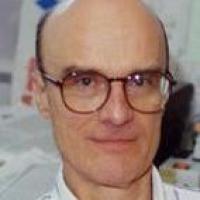R. Bruce Nicklas, Arthur S. Pearse Distinguished Professor Emeritus

I am now retired and my lab is closed. In the past, we pushed chromosomes around by micromanipulation to learn more about chromosome movement in mitosis. We tugged on chromosomes to measure the forces produced by the spindle and chopped spindles apart to locate the motor for chromosome movement. Most recently we pulled on chromosomes to learn to connect cell mechanics with the molecular biology of a cell cycle checkpoint. The checkpoint monitors chromosome attachment to the spindle and helps ensure that the daughter cells get the right chromosomes. Pulling on chromosomes alters the phosphorylation of chromosomal proteins and it causes certain proteins to fall off the chromosome. These changes tell the cell that it is safe to divide. We wanted to understand how mechanical tension, whether from a micromanipulator's needle or from normal mitotic forces, leads to chemical changes in chromosomes and how those changes lead to proper cell division. I have also been interested in evolution, in particular the evolution of mitosis and the role of accidents as well as selection in the origin of species. I no longer serve as an advisor for undergraduate or graduate student research.
Education:
Ph.D., Columbia University, 1958
M.A., Columbia University, 1956
B.A., Bowling Green State University, 1954
Office Location: 371E Biological Sciences Bldg., Durham, NC 27708
Email Address: bnicklas@duke.edu
Specialties:
Cell and Molecular Biology
Evolution
Research Categories: Mitosis and evolution
Research Description: I am now retired and my lab is closed. In the past, we pushed chromosomes around by micromanipulation to learn more about chromosome movement in mitosis. We tugged on chromosomes to measure the forces produced by the spindle and chopped spindles apart to locate the motor for chromosome movement. Most recently we pulled on chromosomes to learn to connect cell mechanics with the molecular biology of a cell cycle checkpoint. The checkpoint monitors chromosome attachment to the spindle and helps ensure that the daughter cells get the right chromosomes. Pulling on chromosomes alters the phosphorylation of chromosomal proteins and it causes certain proteins to fall off the chromosome. These changes tell the cell that it is safe to divide. We wanted to understand how mechanical tension, whether from a micromanipulator's needle or from normal mitotic forces, leads to chemical changes in chromosomes and how those changes lead to proper cell division. I have also been interested in evolution, in particular the evolution of mitosis and the role of accidents as well as selection in the origin of species. I no longer serve as an advisor for undergraduate or graduate student research.
Representative Publications (More Publications) (search)
- Nicklas, RB, How cells get the right chromosomes., Science (New York, N.Y.), vol. 275 no. 5300 (January, 1997), pp. 632-637 [9005842], [doi] [abs].
- Paliulis, L.V. and R.B. Nicklas, The reduction of chromosome number in meiosis is determined by properties built into the chromosomes, Journal of Cell Biology, vol. 150 (2000), pp. 1223-1231 .
- Nicklas, RB; Waters, JC; Salmon, ED; Ward, SC, Checkpoint signals in grasshopper meiosis are sensitive to microtubule attachment, but tension is still essential., Journal of cell science, vol. 114 no. Pt 23 (December, 2001), pp. 4173-4183 [11739650], [doi] [abs].
- Paliulis, LV; Nicklas, RB, Kinetochore rearrangement in meiosis II requires attachment to the spindle., Chromosoma, vol. 113 no. 8 (March, 2005), pp. 440-446 [15711830], [doi] [abs].